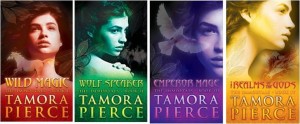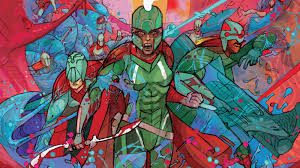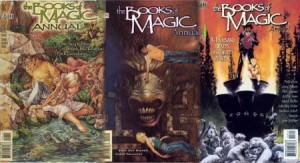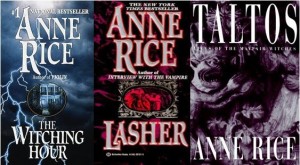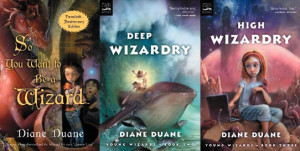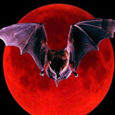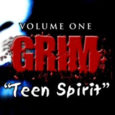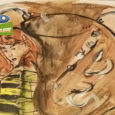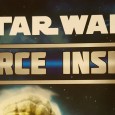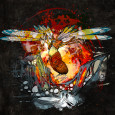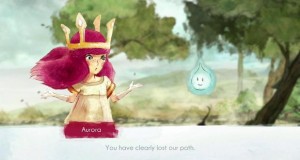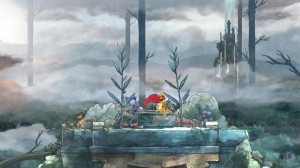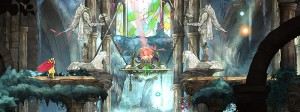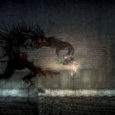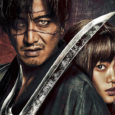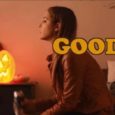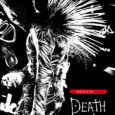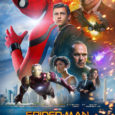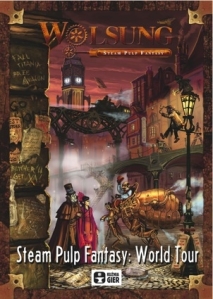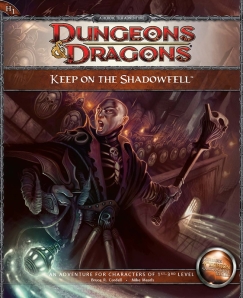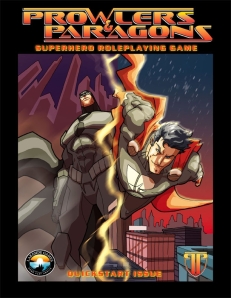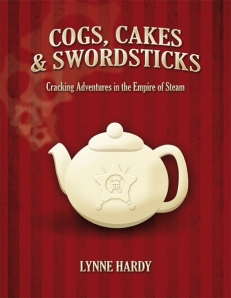When the lights came back on, and the excitement began to wear off, several things lingered after I had time to digest The Hobbit: The Battle of Five Armies. Firstly, the very obvious, and widely noted, lack of female characters lingered, like a bitter aftertaste. It’s no secret that the addition of Tauriel was widely criticized for not being “canon,” and although her character was reduced to that of a love interest in the third movie, it was refreshing to see her get a piece of the action. Elven ruler Galadriel was also given a fight to be part of, albeit again, not canon, and even the women of Lake Town took up arms in the grand battle. It’s a sloppy step, but times are certainly changing. There’s hope for equal representation in fiction now, especially with the announcement of all female Ghostbusters, and an all female version of the Expendables, and women are clamoring to see themselves on screen. There are scores of book series, mountains of graphic novels, hours of vintage films, all in need of a movie, just like the Hobbit, so here’s a look at my top favorite women led properties for a cinematic adaptation (or in one case, a remake)!
Tortall Universe
From our own interview with the prolific Tamora Pierce, we know that the author has some apprehension about adapting any of her beloved Tortall universe into a film. Fifteen published novels currently follow several young heroines on their paths to adulthood through a medieval world of magic and knightly martial arts. Her beasts are fantastical and her queer representation is notable, but one of the reasons we love these books the most is for the diverse featured females characters. While there certainly hasn’t been a dearth of these sort of female-led young adult adaptations, the dystopian future science fiction universes will fall out of fashion soon. It would be legendary if films like the Hunger Games and Divergent were to end up as more than a fad and actually pave the way for other genres like Pierce’s medieval-themed fantasy to get adapted for the screen, especially after the success of the definitely more adult-oriented Game of Thrones.
ODY-C
If anyone told us that we could grant a title of masterpiece to a comic series with only 3 published issues…well that’s as ridiculous as demanding a film adaptation of a series with only 3 published issues. But ODY-C really is that good. We’d actually pay money to attend the pitch meeting to see comic super star Matt Fraction summarize his book as a retelling of the classic homeric myth in space and with all the major characters depicted as women (because that sure went well for ghostbusters). Actually, a more truthful summary would also include that men have been declared taboo by the gods in all of creation so a third gender was created by woman. Science fiction in film deserves to be as progressive and groundbreaking as we expect it to be in other mediums. Let ODY-C take it there.
The Books of Magic
If we didn’t love Harry Potter as much as we do (and we do, oh we do), we’d say it’s a shame that this comic series would appear to movie goers as a rip-off of J.K. Rowlings popular novels, even though it was written first. However, be-speckled teen magician, Timothy Hunter, was created by Neil Gaiman, to introduce readers to magic in the DC/Vertigo comic universe, with inspiration from T.H. White’s The Once and Future King. Tim was given his own ongoing series that took us to the classical world of faerie and the nightmares of young teenage fear. One of the most endearing parts of the early comics penned by John Ney Rieber were the supporting cast of female characters, some magical and some not, that shaped and influenced young Tim’s life. So while not technically a women-led property, The Books of Magic would be a treat to see on screen.
The Mayfair Witches
For too long the witch archetype has been that a decrepit old crone, a negative vision of what a woman in power can end up as. Anne Rice turns this on its head with the matriarchal led family, the Mayfairs, in her mid-90s book series. Taking place in New Orleans, the story centers around the successful neurosurgeon, Rowan Mayfair, as she comes to terms with inheriting the legacy of the Mayfairs, including the family “spirit,” Lasher. The Creole culture is also prevalent, giving ample room for people of color to be cast, as well as having a whopping THREE male characters in the varied cast of characters. A few of Rice’s works have been adapted in the past for the big screen, so why not this one?
Young Wizards Series
Wow, we seem to really like our youngsters when they dabble in the arcane arts. This YA series crossed all sorts of genres, while still capturing adolescence and just how freaking unfair it can be to be a teenage girl. Our main chick Nita receives her calling to be a wizard from a library book, but really learns her craft through out several volumes of sublime examples of urban fantasy, space operas, and natural wonders. If only a studio would be willing to commit the time and money to really flesh out the oceans depths and starry cosmos in the series, we’d really see something spectacular.
Have I missed your favorite series? Is there a classic that should be revamped? Let me know in the comments, or tweet it my way (@deadrabbit92)!
Sit down for an honest review, spoiler-free
for a game full of wonder, sorrow, and fun
Child of Light’s great to play, a few things it missed,
but is overall solid, whimsical, a game that does stun.
Within the past month Ubisoft Montreal brought us a beautiful surprise in the form of a side-scroller meets RPG, Child of Light. Built on the same engine from Ubisoft’s Rayman series, Child of Light is less Rayman, and more director Patrick Plourde and writer Jeffrey Yohalem’s homage to fairytales, classic fairytale illustration, fantasy films and Japanese RPGs such as Final Fantasy.
Even Yoshitaka Amano, the artist who produces both concept art, costume design and logo art for the Final Fantasy series contributed either conceptual or promotional art for Child of Light.
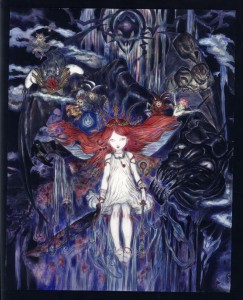
You can see the I believe “extra” party character from the downloadable quest add-on, on the top right.
A short game, with a somewhat fresh or “indie” feel, it’s a certain departure from grittier or more sophisticated work Ubisoft normally puts out. Smaller, more intimate. Artisan.
Child of Light is centered around a young girl from 1895 Austria, the aptly named (and pink haired!) Aurora. Aurora, the daughter of a Duke, contracts an illness that sends her into a death-like sleep, or rather actually…uh, dies? She however awakes upon an altar in a ruined fantasy land, Lemuria, caught underneath the grip of an evil Dark Queen who hid away the sun, moon and the stars. Aurora, gifted a sword and aided by the (on PC) mouse controlled Igniculus, a “firefly” (more like a will-o’- the-wisp in function, whose design vaguely resembles Slime from Dragon Quest) must set out and reclaim said celestial bodies to bring peace back to Lemuria. Aurora too seeks to return back to her father, who himself is ailing following Aurora’s apparent “death”. Along the way Aurora befriends comrades to the cause, effectively expanding her party.
THE GOOD:
First, let me say I am not a good gamer. I am really terrible at videogames. Which is why you never see me over here writing for you in this department often, if at all. I don’t think I have yet! I tend to like artsy, heartfelt games that are on the simpler side in execution. Team ICO holds my heart. But, Ubisoft’s desire to create an “interactive painting, a playable poem” and this game’s fairytale allure made me want to try this game. As a deficient gamer, I was lucky, as this game has two settings, more or less “easy” and “hard” modes called “casual” and “expert” respectively, and it was difficult enough for me on “casual” mode. Which is fine. Because I like to play my games well, more leisurely and I still ran into some boss battles and even just situational battles that were less than smooth. But I liked it that way. So, if you’re not a great gamer and want something fun but not too difficult, this game is definitely for you. In fact I think it would be a great introduction to RPG’s for sophisticated kids and tweens and teens. Or really anyone.
This game is a bit unique in that while the lead is a very feminine looking little girl with pink hair, gifted (eventually) fairy wings, and wields light, her main weapon is a big sword. She is the hero. She is not limited by the game makers to traditionally “girly” attacks or themes despite her hyper-feminine appearance and wearing a nightgown/dress. There is additionally no prince for Aurora to fall in love with. No romance. None. Aurora is a great main character, I loved her a lot. Certainly great for kids to see; we need more main characters like her! Actually all the characters have interesting personalities and elements to their individual stories that are good for growth and learning how to cope with things. What we saw of them, I enjoyed them all.
Another highlight, the music composed by the young (twenty-four year old) but terribly talented musician Cœur de pirate (Béatrice Martin) is inspiring and really provides a great atmosphere with the illustration-like visuals. If they ever release an OST I’d snap it up in a second.
Visually the game is stunning. It is an interactive painting. Incredibly difficult to choose where to screenshot that others haven’t already done. Gorgeous, non-objectified character designs for female characters. Everything, from backgrounds to enemies is either hand drawn watercolor or rendered in gorgeous illustration or stained-glass CGI with lots of bloom and shading. Gorgeously animated. The effect is something similar or reminiscent to Okami (with a more western storybook feel instead of sumi-e, the inspiration for the game coming from John Bauer and other “Golden Age of Illustration” illustrators like Arthur Rackham) and due to the side-scrolling nature of the game, at least a little bit; shades of Paper Mario-like interface.
Some glitches on my PC version through Steam were however, noticeable, mostly Aurora’s very animated hair, would disappear in certain battles effectively giving her a Mia Farrow pixie cut. But that didn’t really bug me too much. I thought the storyline was good, definitely not mold breaking by any means, but overall, solid. Not perfect. But “enough”.
The game overall reminds me of the 2D Aquaria, an indie game from a few (woah actually seven!) years back that was very ambitious with it’s paper-y doll illustrated look and I think still holds up strong as a great game today.
THE BAD:
The faults in Child of Light, while a solid game with it’s own charm, comes mostly from some underwriting when it came to the main plot, some telling vs. showing, and while overall solid, a limited battle system.
I felt story-wise the writing got a little thin at times; I felt I had missed some much needed back-story regarding some characters and was confused at some characters popping up out of nowhere but proving important to the plot. There are also story points and elements going on that we never get a full explanation about why it’s happening (but sound interesting) or further explore. This somewhat lack of roundness particularly for three characters including the big bad and the disjointed pacing that entailed made the game sometimes feel abrupt or again, that I had missed something. I felt the end also fizzled out or felt a bit rushed, jumping from one boss to the final boss without any break or gameplay in between, not even to adjust your assigned occuli to weapons and defense. The final battle was also visually underwhelming compared to what I was imagining or compared to bosses I had gone up against earlier in the game. To be fair, they have confirmed they cut a level leading up to the final boss, but it was simply game play.
Being said I would have also liked more cut scenes and or plot integration with my party. FFX always comes to mind as an RPG that did party interaction and plot specificity rather right. Okami was never terribly difficult and often repetitive but the sheer number of characters, personalities and side quests with high degrees of interactivity with said characters made the game feel so rich. A bit more of that kind of “oomf” and integration would have really made the game.
Some NPC’s in Child of Light even after you’ve helped them, continue their dialogue as if they were still looking for the object that you delivered and now hold in their hand. Small glitches like that take you out of the game. I additionally thought one party member was a bit redundant despite some great spells, and it would have been fun or different had they “joined” an existing member in your party as a duo thus changing up the roster and the stereotypical RPG format instead of taking up another solo spot.
Additionally, while gameplay was fun; you more or less have most of your character’s attacks already; you gain a few new abilities but in general you have the set attacks already. You can acquire new “passive” attacks or increases in your status that assist in battle but with existing attacks all you can do is advance them to apply to multiple individuals and or increase in damage. This is a bit of a downer as one of the cooler parts of RPGs is unlocking and learning new abilities and seeing them being cast/performed for the first time, especially in a time of need. It also encourages you to cycle through your party more as characters get stronger and more useful as they “grow” into their respective roles and offer even more unique attacks.
Given the small development team and short playing time of the game however, I know this is asking for a lot. I understand the limitations. What we did get is still a blast and at it’s core still a good narrative and very playable.
I feel a lot of these issues in Child of Light could be remedied by additional downloadable narrative quests down the line. There is already a downloadable quest with a new party member available who I believe was meant to be there the entire time. If they keep adding additional content, I think it would help the game be even greater than it managed to be; which is still rather great.
I really do recommend this game; there is an official tumblr for it to learn more about it and how they made it. The staff were nothing but enthusiastic and so invested in the game; really check it out and support their hard work.
For the super affordable price at $15, I’d award Child of Light an 8/10.
In all, the game is magical, gorgeous and scary
get it, play it, and let me know with a shout
of what you thought, your feelings,
for Child of Light; do you laud or flout?!
See you real soon!
Max Eber
max@sub-cultured.com
Twitter: @maxlikescomics
Like the perfect wine and cheese, the strudel with le crème, or the beer with another beer, watching the right two movies back to back can bring out the finer, subtler qualities in both. That’s why I’ve assembled a list of my personal suggestions for possible double-feature nights. For the sake of variety (and because I like to challenge myself) I chose to avoid using direct sequels or deliver a double dose of a writer/director in the same pairing.
Get Down! Get Down Again! The Running Man (1987) / Total Recall (1990)
I avoided pairing movies with the same writers, directors, or lead actors…with this one exception, because I for a time was not sure which movie was which. Yeah, Arnold’s action movies are all chock full of one liners, explosions, “babes” of the day, and silly villains with sillier deaths, but these two both throw Schwarzenegger into man on the run situations so similar and satisfying it really is hard to know where one stops and the other begins.
Which to Watch First? The Running Man has some of the most groan worthy one-liners you will ever hear, like when Maria Conchita Alonso asks Arnold what happened to Buzzsaw, who was just previously bisected with a chain saw, Arnold replies “he had to split” and his fight with hockey-themed stalker named Sub-Zero is a standout. Total Recall, for all its 90’s tropes, is still a Paul Verhoven film and has more to it than the simple exterior suggests. The action matches the fun of Running Man and is guilty of its own terrible lines, but getting those laughs out of the way can help you appreciate the solid qualities in Total Recall. The ambiguity on reality, alone gives it points for giving its audience some thinking room. The Running Man

Even in the Future Nothing Works! – The Fifth Element (1997) / Serenity (2005)
These two are an obvious match. They’re both futuristic, space-based, sci-fi action movies with large, ineffective governments clashing with the little guy and except for only one having aliens, both Besson’s and Whedon’s future visions are very culturally diverse. The stories differ but the archetypes are familiar. I could see Korben and Mal getting a drink while Shepherd Book and Father Cornelius discussed scripture, and River and Leeloo finger-painted or beat up tough guys or did whatever two crazy super powered girls would do.
Which to Watch First? I recommend beginning The Fifth Element, and after all the colorful fun, ‘splosions and 90’s end credits music you can jump straight into Serenity’s dustier adventure through the not so shiny future. Elements of Serenity hit a bit harder as well, so best to save those for last. The Fifth Element
Huzzah for 80’s Fantasy! – The Dark Crystal (1982) / Legend (1985)
It is hard to think of many quality live actions fantasy films from the pre-CG era, but these two always to come to mind first. Unlike more memorable fantasy movies in recent history, both of these movies were original stores and not adaptations from source material. The Dark Crystal highlights Brian Froud’s notable creativity and we are lucky that Jim Henson was there to bring these creations to the screen, and amazingly do so practically. Legend uses a classic stable of fantasy creatures such as goblins, unicorns, witches, and Tim Curry but through the use of academy award worthy makeup and prosthetic effects that make them more than stock creatures.
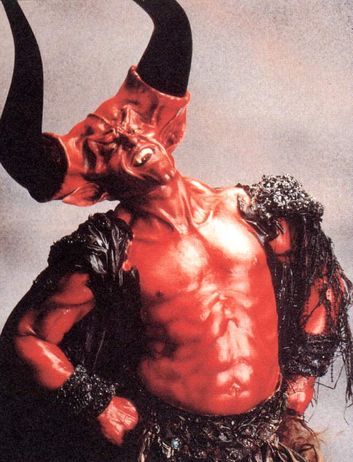
Which to Watch First? Ironically Legend is the decidedly darker of the two movies, and I feel the opening music and narration of The Dark Crystal is a good gateway. Finishing with Legend’s theatrical ending and original closing song by “Tangerine Dream” is more satisfying that Crystal’s successful but strangely somber ending. The Dark Crystal
You’re not Claustrophobic, Are You? – Alien (1979) / The Descent (2005)
After watching these two back to back, you’ll probably want to roll around in a sunny field full of daisies, because anything darker or more confined will give you waking nightmares. While the subsequent films in the Alien franchise are all action heavy, our first introduction to Ripley and the Xenomorph is a tense, ominous, horror movie: seven crew members and a killer alien trapped on cavernous space ship where “no one can hear you scream.” The Descent is one of the best horror films released in the thousands and traps our leads in a literal cave full of hungry mutated humanoids. The jump scares are typical but predominantly very effective making this a fun one to watch with an audience, but the mental instability of lead Sarah and claustrophobic scenes of spelunking are the most riveting.
Which to Watch First? Starting with Alien will give you an intentionally slow crawl into this pairing, and more enjoyable character time before shit hits the fan. The melancholic ending will transition well to the jolting start of The Descent and again I will recommend the original UK ending, as it is unquestionably better and may even make you rethink the ending of Alien. Alien
Video Games and Real Life Had Twins! – Scott Pilgrim vs. The World (2010) / Wreck-it Ralph (2012)
These two love letters to video games and arcade nostalgia pair well because they are two answers to the same question. Scott Pilgrim starts off with an 8-bit Universal title and introduces video game elements into the real world of Toronto, and Ralph puts us a world of video games that functions just like real life (sort of). You’ll have to decide if you’d rather have life like a video game or a video game like life, but if The Sims start playing me I’m going to be worried.
Which to Watch First? Another case in which I will leave it to your taste. I would watch the family film first, and then the one made for grown-ups but they’re similar in tone, pace, and length to not make much difference. Though SP has better music. What you should actually watch first is “Raiders of the Lost Arcade” segment from “Futurama.”

Band On the Road – The Blues Brothers (1980) / O Brother, Where Art Thou? (2000)
Twenty years apart in the making, and over forty in the setting these two films are incredibly different stylistically, but both have a group of musical criminals (or criminally inclined musicians) on the quest for charity and redemption, evading the law and various other colorful enemies they meet along the way. Neither are traditional musicals, but both are driven by a vast array of diegetic performances evocative of the locales the bands go through. They have very different senses of humor, which is why you won’t find Animal House paired with Fargo on this list, but these two form a pair of fun musical episodic adventures.
Which to Watch First? Here I’m really going to say it comes down to taste. Blues Brothers is the more farcical comedy with an upbeat soundtrack and O Brother is a retelling of “The Odyssey” through the music of the Depression-era American South. I’d prefer starting with Blues Brothers, but that’s just me. Tie
Creature Features with Likeable Bait – Jaws (1975) / Lake Placid (1999)
I’m not a huge fan of the run of the mill giant thing wants to eat you type creature features, but Jaws is the oft imitated, never duplicated template that set the bar for the whole genre. One reason Jaws still holds up, while most others do not, is that the human characters and the creature feel like equals and do not overshadow the other. Of course the shark is the anti-hero of the movie, getting his own POV kills before we even meet our full cast but by the time Brody, Quint, and Hoop-ah! set out to get him we know we’re in for a fight. It’s like Rocky II. Lake Placid plays out more like Home Alone 2, if Kevin was played by Bill Pullman, Brendan Gleeson, Oliver Platt, and Bridget Fonda, and the burglars and hotel staff were a giant alligator. And Betty White is the pigeon lady. That cast alone elevates a surprisingly clever script of what I think is an underappreciated, solid creature feature.
Which to Watch First? It’ll be interesting either way, but seeing Jaws begin so many clichés for its genre and then seeing the next generation’s homage garners more appreciation for the tropes than rehashing them because they ought to. You also don’t want to go backwards from the impressive animatronic and CG alligator to the barely functional Bruce. Jaws
The Black and White of Neo Noir – Kiss Kiss Bang Bang (2005) / Brick (2006)
Tonally these movies could not be more different, but they have their roots in similar pulp, noir, detective material and are both revolve around a murder mystery. They are also both products of a sole writer/director on the project, and I find movies like that tend make more of an impression; in this case KKBB and Brick show how differently Shane Black and Rian Johnson can interpret similar source material, while pulling fantastic performances from Robert Downey, Jr. and Joseph Gordon-Levitt.
Which to Watch First? Brick. No question that while Brick is a heavy, gritty movie, you will rather take a walk through those grimy streets first to wind up at a Hollywood party with gay Val Kilmer than the other way around. Brick

Pleasing Your Eye Holes – The Fall (2006) / Pan’s Labyrinth/“El Laberinto del Fauno” (2006)
Guillermo del Toro’s Pan’s Labyrinth is the more well known of these two, and even though they came out the same year and had many similarities, Tarsem Singh’s The Fall remains largely unknown to people who aren’t Lee Pace fangirls. Both of these films use the imaginations of young, traumatized girls as gateways to strikingly visual fantasy worlds. Putting these two films from foreign auteurs together is like matching The Wizard of Oz with Alice in Wonderland with more whimsy in the setting than the words.
Which to Watch First? Most people have already seen Pan’s Labyrinth and even though it is subtitled, while The Fall is in English, del Toro’s narrative is easier to follow and the world is more instantly engrossing. Pan’s Labyrinth / El Laberinto del Fauno
Non-American Love for American Action Movies – Hot Fuzz (2007) / Seven Psychopaths (2012)
It can be said that if you’ve seen one action movie you’ve seen them all, but that’s because for a lot of movie buffs they literally have. I wouldn’t call either of these movies parodies but Edgar Wright’s Hot Fuzz and Martin McDonagh’s Seven Psychopaths have a lot of laughs and fun with honest appreciation for all the good and bad action movies so influential to their careers. Hot Fuzz calls out its targets by name and is an Easter egg hunt of direct references, while Psychopaths is a more meta deconstruction of the genre and the writing process, but still with lots and lots of violence. To quote Sam Rockwell’s character, “Life-affirming, schmife-affirming. It’s called Seven fucking Psychopaths!”
Which to Watch First? Seven Psychopaths’ opening scene comparing the deaths of movie mobsters with real mobsters, delivered by Michael Pitt and Michael Stuhlbarg of Boardwalk Empire (a show about mobsters), so quickly sets the course for this movie’s take on reality that I was on board from the first few lines. While not as dark as McDonagh’s previous film, In Bruges, Psychopaths is big on the death, but the critiques it makes on the genre will be appreciated when revisited in the overall funnier Hot Fuzz. Seven Psychopaths

I think it can be said that once Disney adapts a fairytale, the adaptation will eclipse the original story in the public’s consciousness. This rings especially true for their huge 1989 hit The Little Mermaid. Disney’s version is so influential that the name Ariel for many people under thirty no longer evokes the spirit in The Tempest but instead the dreamy red haired mermaid. Her iconic Glen Keane hair and green tail have influenced the depiction of mermaids, even in non-Disney merchandise, ever since.
The most disappointing result of this monopolization is that the Disney version, with its clear-cut villainy and happy ending, has in many ways diminished the awareness of the complexity found within the original story. In fact it has been posited that the story was written by Andersen as an expression of his pain for loving a young man which for many reasons was unrequited and could never be. It comes as a surprise to many people that the original tale has a considerably “bad end” for the Little Mermaid herself.
Luckily for those who want to become familiar with or are already fans of the original story there are a handful of both animated and film iterations, mostly from Russia in the 1950s to 70s. The Soviet studios of the time were very limited in what they could do; often the choice was between propaganda films or encouraged by the government adaptations of folk and fairytales and classic literature. Because of that choice, many of the most beautiful and true to source adaptations of fairy tales and novels like The Jungle Book and Andersen’s other masterpiece The Snow Queen come from animation studios like Soyuzmultfilm during that period.
Spinning out from that era is the 1976 live-action Czech film adaptation of “The Little Mermaid”, Malá morská víla. Directed by Karel Kachyna the film is a sensational but well-kept secret that should receive more attention not just as a faithful adaptation but also as a beautiful stand-alone film. Clocking in just under an hour and a half the film is sensitive, introspective and an utterly dreamlike piece that is unique amongst all iterations of the story in its balanced approach to saying faithful to the text and taking its own creative liberties (just like Disney did).
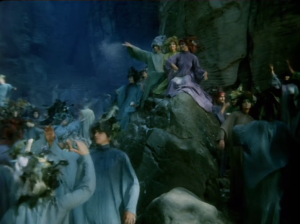
The first liberal and perhaps the most notable change is that the mermaids of Malá morská víla are presented as gossamer creatures, cloak-wearing water spirits, sans fish-tails (a point the Sea King in the movie openly mocks) of an unnatural pallor and elaborately twisted and sculptural hair decorated with found trinkets and seaweed. What’s more, these mermaids are not harmless. Their singing and the Sea King’s magic stones, much like the sirens and water spirits of lore, openly cause storms or hypnotize sailors and cause shipwrecks just for fun, after which they gleefully pillage for effects in a ceremonial fashion. There is a pronounced otherworldliness to their culture outside of the usual “I have fins and as such it is impossible to fraternize with humans” that has become standard in most modern tellings.
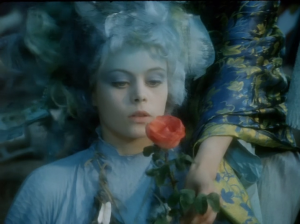
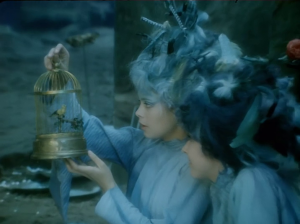
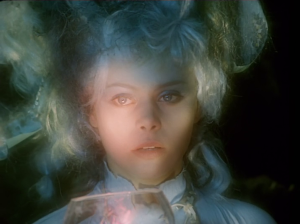
These choices makes all the difference. The world and culture of the mermaids, the Little Mermaid (played by the stunning Miroslava Safránková)’s year long curiosity about the human world after rescuing the Prince, and a subtextual storyline concerning her deceased mother, all take considerable emphasis over the actual romance of her and the Prince. In fact The Little Mermaid doesn’t transform and arrive on land until nearly sixty minutes into the film. Another element that is preserved from the original story is that the Sea Witch, while diabolical, is not vilified like the Disney version of Ursula. Unlike the original tale, the Sea Witch does not provide the Little Mermaid with a last minute solution to transform back into a mermaid should she fail to win the Prince’s heart. The dagger given to her to kill the Prince and his new wife and grant her the ability to return to the ocean is instead now attributed to the Sea King, which further removes the involvement of the Sea Witch from the story past her initial spell on the Little Mermaid. This choice is refreshing and adds additional complexity to the relationship between father and daughter.
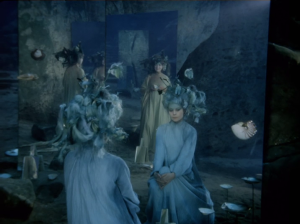
The costuming and make-up work paired with the dreamy and painstakingly arranged sets, lighting, choreography and notable music all together truly creates a convincing murky underwater world of blue and grey and white for the mermaid’s kingdom without any actual water; this Little Mermaid is hardly ever actually wet in this film. The human world above in contrast is a palette mainly full of red, whites, apricot-salmon pinks, browns and muted turquoise-blue that is present all the way down to the lead’s complexions and hair colors. All above the water is bathed in almost stark sunlight which continues the film’s gorgeous cinematography choices in the human world as much as they did when under albeit in a more subtle manner.
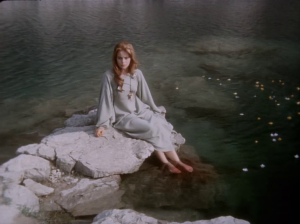

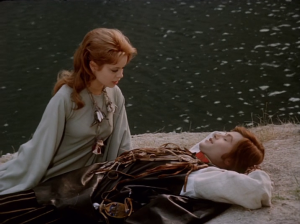
This film, despite its own unique changes to Andersen’s original, is the most sensitive and successful live action adaptation of the story that I have seen barring the Russian animated version from 1968 Rusalochka which is also worth watching for it’s stunning stylized animation. It both expands the character of The Little Mermaid and stays at the core a faithful and beautifully melancholic interpretation that celebrates the beauty of its own sadness. Although it is hard to find with English subtitles, it is worth seeking out in HD either on DVD (or torrent at Eutorrents shhh) or watch it subbed here. You can also watch the entire film without any subs here. For fans of fairy tales, fantasy films, and seventies art films, this movie is a gem and is one of if not my favorite fairy-tale adaptation on film, period. A must watch.
Please if you haven’t seen this film and do watch it, let me know what you think of this adaptation!
Max Eber
Staff Writer/The Doctor
max@ihogeek.com
Twitter: @maxlikescomics
Free RPG Day started in 2007 that means this is the 6th year that we get some free RPG goodness. So as a companion piece to my last article, here are some great ways that are super free to get into RPGs. You can find all of these through the links I include or on DriveThruRPG.com
1. Wolsung: Steam Pulp Fantasy (World Tour) – Find it here. Wolsung will actually appear twice as this great steampunk RPG has not one but at least 2 free products this Free RPG day!
2. Keep on the Shadowfell & Quick-Start Rules (4e) – It’s right here! This is one of the best places to start with D&D’s 4th Edition, you get the module, the quick start rules and loads of awesome information to get started for free!
3. Prowlers and Paragons – Capture the villain right here. Remember Mutants and Masterminds? This rules lite RPG is in the same vein but much more fluid. You want to smash into a bank vault or fight across a city scape? This game is for you. Full of tights, traitors, and tortured heroes.
4. Wolsung: Steam Pulp Fantasy (Test Drive) – Investigate something Victoriana here. This is the second book from the team at Studio 2 Publishing, realistically it should have gone first on this list because it is the quick start rules for the setting and system but I just like the other book so much.
5. Cogs, Cakes, and Swordsticks – Just a little more Victorian Alt-History, right about here. Cogs, Cakes, and Swordsticks is everything that pulp victorian roleplaying should strive to be, simultaneously fun and dark it strikes the right balance for each player set against the backdrop of Victorian London in the British Museum this game is just plain fun, and free, did I mention free?
There are many other free PDFs available on sites like Drive Thru RPG right now! Don’t miss out on all of this gaming goodness!
Samuel Smith
Staff Writer
@samwasbornanerd


